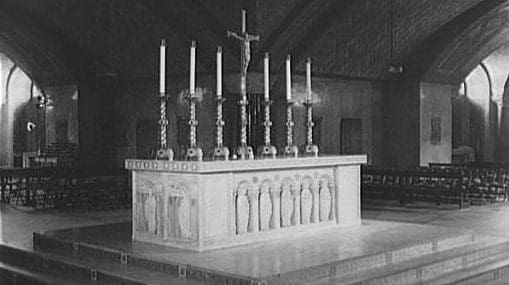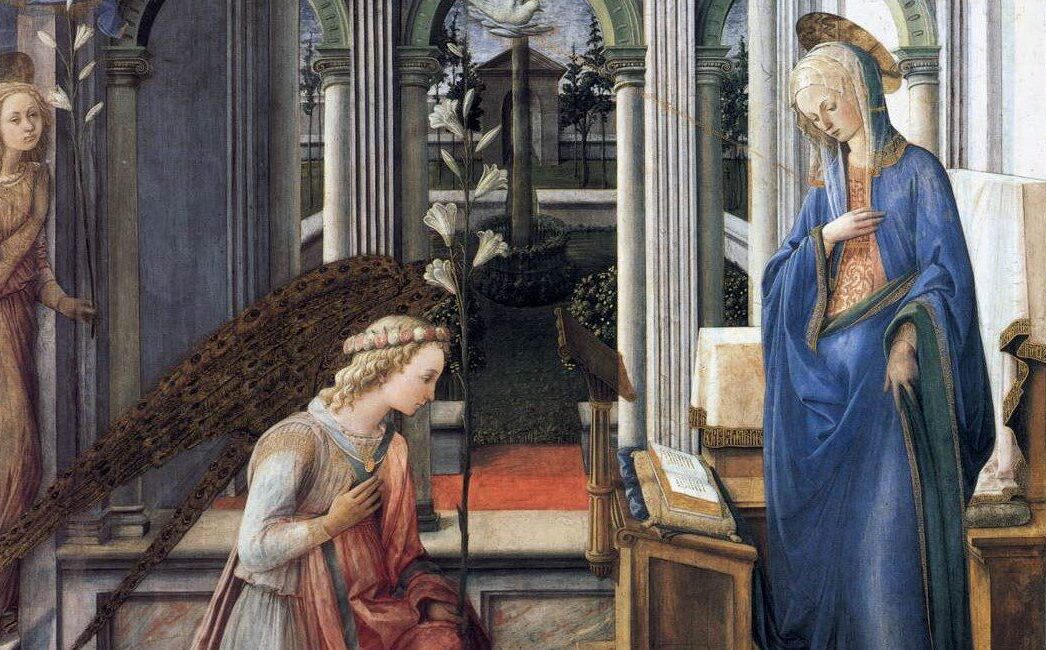Editor’s note: The altar stands at the heart of the church building. Indeed, it represents not only the heart of Christ, but also of Christians. Bishop Peter Elliot unpacks this core teaching in three entries, the first of which Adoremus is grateful to offer in this issue of AB Insight.
In every Catholic church we find an altar. In a remote mission station, the altar may be the only object in a simple open structure. This suggests that every church is constructed primarily to contain an altar.
Therefore, a church may be described broadly as a covered place where God gathers the Christian community led by a priest to do what Jesus Christ commanded at the Last Supper, to celebrate his Eucharistic Sacrifice. The essential object in the church, the central focus for worship, is this sacred table where the priest celebrates the Divine Liturgy.
The other furnishings of a church are derived from the altar or relate to it starting with the baptismal font where the first sacrament of Christian Initiation is celebrated. Baptism always leads to the Eucharist and establishes a place for us in the hierarchy of worship and service that is the Church.
The ambo or lectern for the proclamation of the Word of God is the “table of the word,” leading to the “table of the Eucharist.” The cathedra or a presiding chair is reserved for the bishop or priest who will stand at the altar. Around or near the altar are places for the people, servers, readers, and choir. One Eucharistic community is celebrating with and through the bishop or priest. Closely related to the altar is the tabernacle, the tent of God, for reserving the Blessed Sacrament so that those unable to gather at an altar can receive the Lord wherever they may be. The adoration of the reserved Sacrament extends the action of the altar and leads us back to it.
The Altars of Israel
Most religions have “altars,” but the word is often used loosely to describe what are really shrines or places for sacred images. Strictly speaking the word “altar” refers to a table or similar structure where sacrifices are offered to God or, in pagan times, to the gods.
The Old Testament includes many references to altars where sacrifices of animals, wheat, etc., were offered and usually burnt: the holocaust. A rather complex system of sacrifices developed in Israel. Altars were set up first in the tabernacle tent of the desert, then in various sacred sites such as Shiloh, and finally in the great Temple established on Mount Moriah in Jerusalem. The obligatory domestic rite of Passover also required the annual sacrifice of an unblemished lamb. The sacrificed lamb was eaten in a sacred meal, a great memorial celebrating and reliving the liberation and covenant of God’s People Israel.
Jesus Christ ended the Temple sacrifices when he changed the Passover into his own sacrificial meal for his new Israel, the Church. He gave himself as the “Lamb of God” in a true sacrifice and sacred meal at the Last Supper, when a domestic table became an altar.
At that ritual supper, he ordained his apostles as priests of a new covenant by a divine creative word of command: “Do this in memory of me.” What he did, they were obliged to do—not as priests of the family line of Aaron but priests of the mystical “order of Melchizedek.” His atoning and reconciling work was revealed to them when he accomplished his saving mission on the next day, and a criminal’s cross became an altar.
That cross was later understood as pointing to another “altar” beyond this world, a symbolic way of describing the eternal self-giving love within God the Trinity: the Son offered to the Father in the unity of the Holy Spirit. The Letter to the Hebrews describes the self-giving of Christ, beloved Son and High Priest in eternity. In himself, Jesus absorbs the roles of Priest, Victim, Temple and Altar. The earthly altars of his People link us to that eternal offering of love in God’s eternity.
The Great Sign of Christ
It is therefore appropriate to describe the Christian holy table in each church as the “great sign of Christ.” The altar has no meaning apart from Jesus. This is why the altar is located in a central position, for he is at the center of our worship. Because Our Lord is beautiful, his great sign is meant to be an object of beauty and splendor, worthy of the sacrifice and real presence of the Lord himself.
Nothing is to be placed on the altar except what pertains to the Lord’s Eucharistic sacrifice and banquet. It is also a permanent object, one reason why most Catholic altars are fixed onto the floor and usually made of stone or marble. Christ is the Rock of his People, true God and true Man, with us forever, always among us.
The symbolism of the altar as the great sign of Christ is revealed when a new altar is dedicated by the bishop. He first sprinkles the people and altar with holy water. After the Liturgy of the Word the altar is dedicated (or set apart) with a solemn prayer. Then the bishop anoints it with the most sacred oil, Holy Chrism, and it is crowned with a blazing fire of fragrant incense. These are signs of the work and presence of the Holy Spirit, who is one with Our Lord, “the Christ,” the “anointed One.” Henceforth, this anointed table can only be used for one purpose — the celebration of the Lord’s Sacrifice and Banquet.
After it has been dedicated, the great sign of Christ is dressed with the cloths, crucifix, and candles that are used at every celebration of the Eucharist. Finally, something essential takes place on this altar that is its real dedication: the bishop celebrates Mass on it. Here we pass beyond mere symbolism, for Christ himself becomes really, truly, and substantially present among us in the celebration of his Sacrifice. His Body and Blood are offered up for us, then given to us to be received at his sacred table.
The Altar’s Eucharistic Meaning
The earliest Christian altars were made of wood, obviously because Mass was often celebrated in people’s homes. But apparently a prominent stone table in a central place in a Roman villa was also used. Once public churches could be built, altars began to be constructed of stone or marble. Today, we follow these ancient traditions in altars made from stone, fine marble, or solid wood. A stone altar is a sign of a permanent place of sacrifice linking us with our Jewish heritage, because the altars described in the Hebrew Scriptures were made of stones.
However, the Christian altar is not only a holy place of sacrifice. As the beautiful prayers of dedicating an altar remind us, it is at the same time the holy table of the Supper of the Lord, where the faithful come to be nourished by the Body and Blood of Christ. When it is dedicated, it is proclaimed as “a festive table,” “a place of intimate communion with you and a place of peace,” “a source of the Church’s unity and of fraternal harmony,” “the center of our praise and thanksgiving.” Therefore, the Lord’s table on earth is a foretaste of the heavenly banquet that awaits faithful Christians—“blessed are those called to the supper of the Lamb.”
The altar itself draws together the two complementary dimensions of the Mass—the holy sacrifice and the holy meal. It is not a matter of “either/or.” The Mass is both a saving sacrifice and a sacred meal.
At the hands of his priests, Jesus offers his Body and Blood for the living and the dead, and then he gives us his offered Body and Blood to be our food of eternal life. How wonderful is the Lord’s sacred table where these mysteries are accomplished! As noted, as the most sacred object in our churches, the great sign of Christ himself, the holy table is centrally located. It is the heart of the sacred place where God gathers his priests and people to worship in the Eucharistic way he has revealed and given to us in his Church.
Is an altar essential for Mass? Not always. In times of persecution, it may not be possible to use an altar. I recall a moving account of a secret Mass celebrated in a Russian restaurant during Communist oppression in that country. Likewise, in Penal Times in Ireland, the “Mass rock” was used for celebrating the liturgy “under the hedges.” Yet in difficult circumstances priests and people would try to do their best for there is also a long tradition of using small portable altars. A consecrated stone or blessed cloth (antemension) can be transported and placed anywhere. Instantly an altar is provided. But for Christians, what matters is not a place or object, but how we worship God wherever we may be, “in spirit and in truth” (John 4:23).
By Baptism, we are gathered by God at the altar, for we do not gather ourselves. By Baptism, each of us is called to be a spiritual altar, for we are priestly people offering sacrificial praise and prayer in our hearts. On the pilgrim way of Christian life, we are being built as the living stones of the altar of the mystical temple, for that is the whole praying Church.
Bishop Elliot will look back upon the history of the Christian Altar in the next installment.
Most Rev. Peter J. Elliott is Auxiliary Bishop Emeritus of Melbourne and holds degrees in history (Melbourne), theology (Oxford), and a Doctorate in sacramental theology, Lateran University, Rome. Because of his Anglican background, he was the delegate of the Congregation for the Doctrine of the Faith and the Australian Bishops’ Conference for establishing an Australian Ordinariate for former Anglicans. Having been a Consulter to the Congregation for Divine Worship, he was a Member of the interdicasterial commission “Anglicanae Traditiones,” preparing liturgical texts for the Ordinariates. He was a member of the Australian Bishops’ Liturgy Commission and the Australian National Liturgical Council. Bishop Elliott is the author of Ceremonies of the Modern Roman Rite (Ignatius Press, 1995, 2005), Ceremonies of the Liturgical Year (Ignatius Press, 2002), and Ceremonies Explained for Servers (Ignatius Press, 2019).



